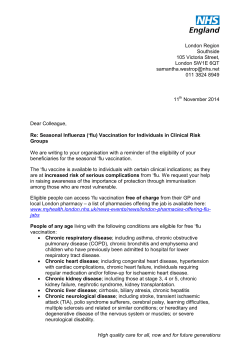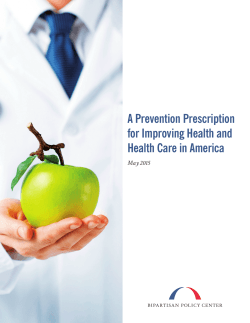
the fact sheet - Bipartisan Policy Center
Prevention Task Force Preventable chronic diseases now affect half the U.S. adult population and account for the bulk of U.S. health care costs. Prevention strategies focused on risk factors for these diseases are critical to improving citizens’ health and reducing health care costs. i, iii In 2014-2015, the Bipartisan Policy Center (BPC) convened the Prevention Task Force to focus on prevention and to frame a strategy for fully integrating prevention into the nation’s approach to health and health care. The Key Facts • Chronic disease dominates health care costs. 86% of U.S. health care costs can be attributed to chronic disease.i, iii • Despite huge expenditures on health care, Americans do not experience better health. Americans spend 2x as much on health care as citizens of other developed nations, and yet 50% of American adults have a chronic disease.i, ii, iii, iv • Several obstacles prevent the United States from implementing an integrated, prevention-focused approach to health care. Fee-for-service payment models do not reward physicians for counseling patients on preventive changes to improve health. Health care providers have historically operated with little or no connection to nonmedical, community-based organizations. bipartisanpolicy.org @BPC_Bipartisan facebook.com/BipartisanPolicyCenter @BPC_Bipartisan Addressing the Crisis Task Force Members In its 2015 white paper, A Prevention Prescription for Improving Health William H. Dietz, M.D., Ph.D. the task force identified a two-part framework to accelerate investment in Director, Sumner M. Redstone Global Center for Prevention and Wellness; Milken Institute School of Public Health at the George Washington University prevention-oriented strategies that will improve health outcomes and lower Ron Goetzel, Ph.D. and Health Care in America (bipartisanpolicy.org/prevention-prescription), health care costs. Senior Scientist, Department of Health, Behavior and Society; Bloomberg School of Public Health at Johns Hopkins University 1. Build the evidence base on the value of prevention. Jeff Levi, Ph.D. Capture and translate the best available information about what Executive Director; Trust for America’s Health interventions are effective in reducing identified risk factors, improving Matt Longjohn, M.D., M.P.H. population-based health outcomes, and reducing costs. 2. Make prevention a key part of health care delivery system reform. Shift the existing health care delivery system from volume to value-based care delivery and payment by including prevention strategies and forging National Health Officer; YMCA of the USA Tracy Orleans, Ph.D. Senior Program Officer and Senior Scientist; Robert Wood Johnson Foundation Murray Ross, Ph.D. Vice President; Kaiser Foundation Health Plan, Inc. Director; Kaiser Permanente Institute for Health Policy new partnerships among community organizations and traditional providers. The BPC Prevention Task Force is motivated by a core premise: that prevention, along with an integrated approach to health and health care can improve patient outcomes and experience, while reducing health care costs. Given Americans’ high rates of chronic disease, the complex health care challenges the nation faces, and the fact that the most important influences on people’s health happen outside the clinic, prevention is essential to achieving better health outcomes and lower costs for all Americans. To read the full report and view the full list of task force recommendations, visit bipartisanpolicy.org/prevention-prescription. Senior Advisors Senator Bill Frist, M.D. Former U.S. Senate Majority Leader BPC Senior Fellow Alice M. Rivlin, Ph.D. Senior Fellow, Economic Studies Program Brookings BPC Health Project Leader, Delivery System Reform; Long-term Care Secretary Dan Glickman Former U.S. Secretary of Agriculture BPC Senior Fellow Our Staff Centers for Disease Control and Prevention. “Chronic Disease Prevention and Health Promotion.” Centers for Disease Control and Prevention, 2015. Available at: http://www.cdc.gov/chronicdisease/. Lisel Loy ii Ward, Brian, Jeannine Schiller, and Richard Goodman. “Multiple Chronic Conditions Among US Adults: A 2012 Update.” Prevention of Chronic Disease 11.4 (2014). Hannah Martin iii Organization for Economic Co-operation and Development. OECD Health Statistics 2014: How does the United States compare? Paris: OECD.org, 2014. Available at: http://www.oecd. org/unitedstates/Briefing-Note-UNITED-STATES-2014.pdf. Caitlin Krutsick i iv Central Intelligence Agency. The World Factbook 2013-14. Washington, DC: Central Intelligence Agency, 2013. Available at: https://www.cia.gov/library/publications/the-world-factbook/index.html. Director, lloy@bipartisanpolicy.org Policy Analyst, hmartin@bipartisanpolicy.org Administrative Assistant, ckrutsick@bipartisanpolicy.org Robin Schepper Senior Advisor, rschepper@bipartisanpolicy.org Founded in 2007 by former Senate Majority Leaders Howard Baker, Tom Daschle, Bob Dole, and George Mitchell, the Bipartisan Policy Center (BPC) is a nonprofit organization that drives principled solutions through rigorous analysis, reasoned negotiation, and respectful dialogue. With projects in multiple issue areas, BPC combines politically balanced policymaking with strong, proactive advocacy and outreach. For congressional inquiries, please contact: Ashley Ridlon aridlon@bipartisanadvocacy.org For media inquiries, please contact: Joann Donnellan jdonnellan@bipartisanpolicy.org
© Copyright 2025












